
It's a funny thing that happens when the stress of financial insolvency bubbles up to the surface. Decisions once considered "routine" (like brushing one's teeth or walking one's dog) suddenly have life-or-death outcomes, complete with cold sweats, sleepless nights and self-prescribed medicinal relief. Whenever I turn on the financial news stations, such as Fox, Bloomberg or CNN, I get the impression that I am watching Kabuki theatre, with exquisitely-designed puppets playing out exquisitely crafted scripts. I am immediately faced with the ageless problem of whether or not to consider the content "news," or should I view it as simple "entertainment."
By example, the saber-rattling of the United States of America in its anti-China rhetoric is playbill material of the highest order. You have in the red corner the aging heavyweight champion, long seated on the throne of global military and economic dominance, while in the blue corner, you have the spry young contender, hungry from decades of communist suppression and poverty with a highly motivated populace and a powerful and rapidly growing military. As much as the world may loathe it, it appears that the bell is soon to sound and the battle for global supremacy is about to begin.
The problem lies not in the war itself but in the collateral damage about to be inflicted upon the those close to the battlefield. However, at the end of the day, as the night when a youthful Rocky Marciano knocked an over-the-hill Joe Louis through the ropes, 330 million Americans trying to engage 1.433 billion Chinese is like taking a knife to a gunfight, and by that, I do not refer to an altercation of armies. I refer to an altercation of willpower.
For thousands of years, Chinese culture has taught people to think in terms of generations, while American culture has been trained in terms of days, hours and minutes. Since the end of WWII, America has fancied itself as the rightful heir to the hegemonic throne, aided and abetted by Hollywood, and its educational system that has promoted the concept that the only soldiers fighting on the side of freedom and against the Axis of Evil were the Yankees. All through the Cold War and now into the New Millennia, the Teddy Roosevelt concept of "speak softly but carry a big stick" has been replaced with "shoot first and ask questions later," with the American forces, for the first to time invading a foreign nation—unprovoked (remember the imaginary weapons of mass destruction of the second Iraq Invasion?).
By contrast, the Chinese have opted for symbolic power, and as a result, the world is now ablaze with confrontations, literally everywhere, as the result of American-led imperialism. Only just recently has China flexed its muscle with the protests ongoing in Hong Kong, but by and large, the ramifications of two mammoth economies now in all-out conflict stands to be seen as epic, and there is very little if anything that can be done to prevent an economic winter in trade and standards of living.
The first casualties of such conflict will be currencies, where purchasing power begins to erode slowly but then completely vaporizes, as seen throughout history, in Wiemar Germany, Zimbabwe and, more recently, Venezuela. The first beneficiaries of such conflict are the ageless stores of value in gold and silver. Physical possession of one's wealth is the cardinal rule of survival when financial Armageddon arrives; just ask any of the survivors of the nations hit with hyperinflations the importance of possession. Nowhere is the phrase "possession being nine-tenths of the law" more relevant than in chaotic societies.
The financial news and, more recently, social media have become the preferred conduits for financial propaganda by corporations, investment houses, politicians and presidents. Whatever the medium, managing both expectations and behaviors of the consuming public is used by everyone to advance either a product or a concept, and it has grown out of control to the extent that I now find it virtually impossible to differentiate between targeted messaging and actual reporting. So when I read that there is a "pending trade deal with China," I completely discount it, because 90% of the time it is floated by either an administration official (like Larry Kudlow) or a Wall Street reporter (like Steve Liesman) in order to herd the algobots into buying stocks.
Larry Summers was the master of "behavioral economics," and it was here that was born the acceleration of the asymmetrical wealth effect as an economic tool by which policymakers could sway consumer buying trends. From the Crash of '87 onward, the importance of elevated stock markets morphed into an important policy tool, to the point where here, in 2019, President Trump appears obsessed with it and tweets algobot-sensitive buzzwords like "China deal" and "lower rates" in order to goose the markets. The underlying reason for all of this is to distract the masses away from the reality of the disintegrated middle class and eroded living standards, all the direct result of the errant actions of the Federal Reserve and its global central banking brethren, who collectively have brought a new level of disrespect for the integrity of purchasing power of all currencies in all nations. "If stocks are up and gold is down, things must be good, right?" Perception is nine-tenths of reality.
COT Report
Comments are found in the graphic provided below.
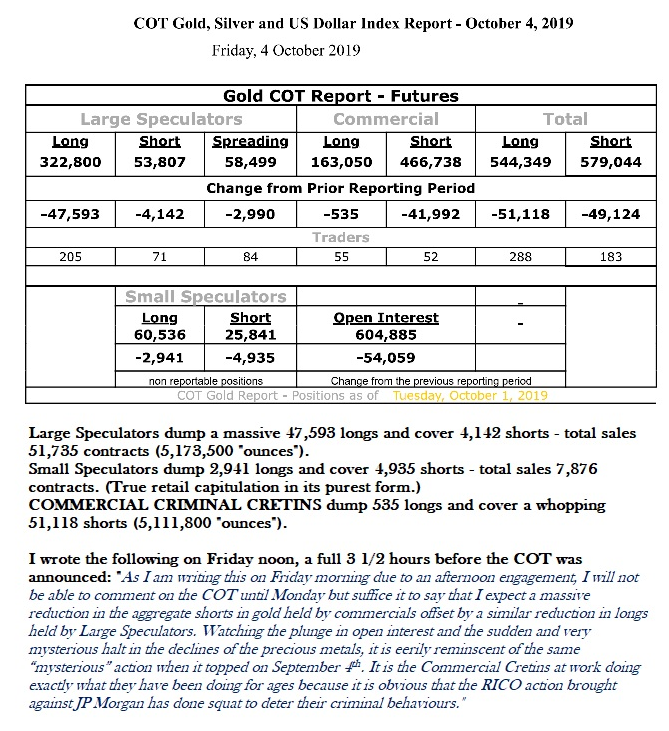
I scooped the chart shown below from my buddy David Chapman (enrichedinvesting.com), with whom I used to work while toiling for Union Securities from 2004–2011. David is a market historian and a card-carrying member of the Society of Technical Analysts, and feels that the markets have topped, as shown in the breakdown from a rising wedge formation from last week.
With bearish chart configurations such as this, I normally opt for a smattering of shorts and put options. As we have seen in the past, they have tended to be lucrative until that point where the screams from Wall Street and the sitting President force into action the Working Group on Capital Markets (the PPT), after which short sellers get immolated in a frenzy of government-triggered buy orders from a financial source that rarely, if ever, gets a margin call, and has deep, unlimited pockets. Market adversaries like the U.S. Treasury are not to be trifled with because they cannot and do not lose. Hence, I opt for volatility trades such as the TVIX or the UVXY, or calls on the VIX index. It is akin to betting on "weather" as opposed to choosing "sun" or "rain."
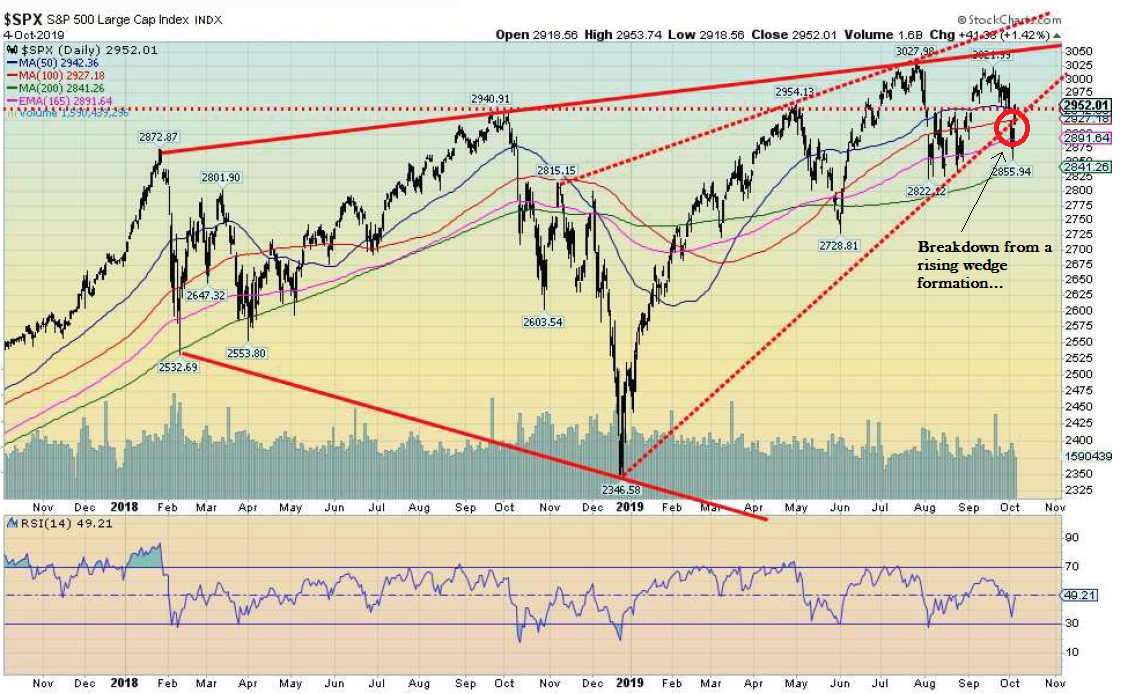
For those of you following my Twitter feed, you know that I have called for a huge spike in volatility (VIX) since Sept. 16, and have already traded the TVIX once from the low $13s to over $16. Well, yesterday, I reloaded the gun with a full long position in the TVIX at $13.75, and was tempted to add more prior to Jerome Powell's "This is not quantitative easing (QE)" speech, which has to be the most laughable plausible denial in history. You are buying several hundred billions of T-bills in order to force short rates lower while bragging of a 3.5% unemployment rate and a "booming" economy, and yet you refuse to call it QE? These are the times that I want to launch my Groucho Marx paperweight directly into the Jumbotron TV showing the professorial forehead of not only Powell but also the shiny cranium of CNBC economics reporter Steve "The Fed Can Do No Wrong" Leisman.
I am long a substantial TVIX position in the GGMA portfolio from yesterday, committing 50% of all cash reserves to the TVIX, representing a 19.66% allocation. That is a rather large bet for a portfolio dominated by gold, silver and miners of same. It is also a testimonial to my current state of readiness, alarm, and apprehension as to the risks inherent in the global markets. As I wrote about a few weeks ago in "Something Wicked This Way Comes," dated Sept. 24, I cannot exactly pinpoint the precise reason for my anxieties, but I can say that trading against my gut feel has hurt me immeasurably over recent years and with today's absurdity levied upon us by the Fed Chairman, these REPO operations are not carried out because things are rosy. They are "emergency measures," and if you want me to wage a guess, I would say that a large Eurozone bank whose noxious derivative tentacles intertwine with Walls Street's (and whose response to questions regarding possible insolvency is an abrupt "Nein!!") is in big trouble. I'll let you figure it out. . .
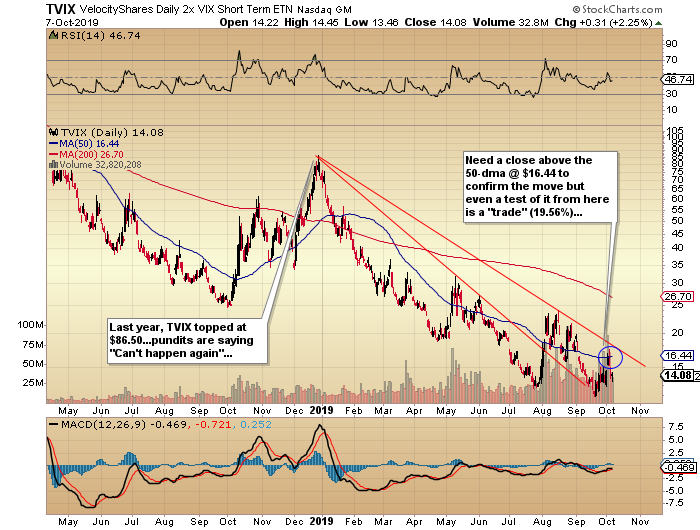
Tuesday's session ended poorly, with stocks going out "hard on the lows," but with the VIX and the precious metals well-bid. Gold miners (HUI + 2.96%) outperformed the metals, with silver (+1.43%) outperforming gold (+.45%), a letter-perfect configuration for a continuation move. Last year's stock market blow-off started to gather steam around this time and didn't end until Christmas Eve, after Smilin' Stevie Mnuchin called in the PPT goons to save Wall Street from a year-end disaster never before seen in the annals of Wall Street History.
Just as past performance is no guarantee of future results, past equity market crashes accompanied by gold market advances are by no means a guaranteed repeat, but the fact remains that the global economy has slowed to a standstill, and that the singular driver that has justified the past 10-year bull market—growth—is now gone. Without it, all that remains is the music, and when the music stops, try finding a chair when all of them are owned by Fed governors.
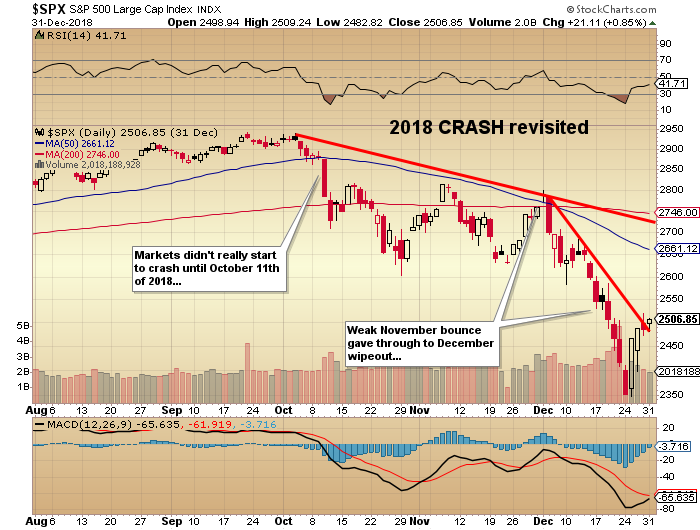
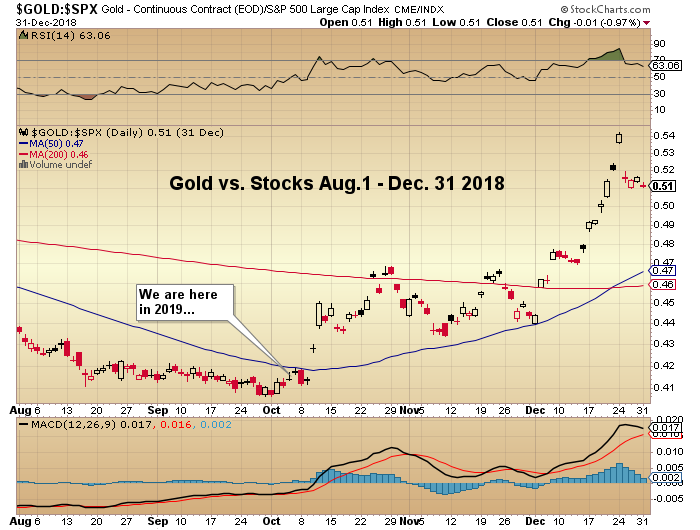
The words of Fed chairman Powell were as chilling as I have ever heard. In forty-two years of reading and listening to the words of Paul Volcker, Alan Greenspan, Ben Bernanke, Janet Yellen, and now Jerome Powell, I have never before heard such an astonishing display of prevaricative showmanship, through which he attempted to convince us that a Fed balance sheet expansion was not in any way a return to the 2008 crisis policy actions known as QE. To be clear, all moves by central banks to "shore up liquidity" involve the simple process of manufacturing cash, a process known as "counterfeiting," to the average law enforcement officer.
The mere mention of Fed "stimulus" in prior times has resulted in massive upswings in stocks. But today (Tuesday), unlike 2008, and unlike 2002, and unlike 1998, and unlike 1987, the markets heard the news of a return to Fed balance sheet expansion and they indeed rallied. Sadly, after things settled down, the light bulb went on and the words of "economic health" were replaced by that malaise of which I referred last month—mistrust. Realizing that Powell had the lipstick out, they sold them hard right into the final bell.
Stay long precious metals and add on dips. Sprinkle in a tad of volatility and a sprig of index puts and we may all have a very peaceful Thanksgiving and remember, something wicked. . .
Never mind.
Follow Michael Ballanger on Twitter @MiningJunkie.
Originally trained during the inflationary 1970s, Michael Ballanger is a graduate of Saint Louis University where he earned a Bachelor of Science in finance and a Bachelor of Art in marketing before completing post-graduate work at the Wharton School of Finance. With more than 30 years of experience as a junior mining and exploration specialist, as well as a solid background in corporate finance, Ballanger's adherence to the concept of "Hard Assets" allows him to focus the practice on selecting opportunities in the global resource sector with emphasis on the precious metals exploration and development sector. Ballanger takes great pleasure in visiting mineral properties around the globe in the never-ending hunt for early-stage opportunities.
Disclosure:
1) Statements and opinions expressed are the opinions of Michael Ballanger and not of Streetwise Reports or its officers. Michael Ballanger is wholly responsible for the validity of the statements. Streetwise Reports was not involved in any aspect of the article preparation. Michael Ballanger was not paid by Streetwise Reports LLC for this article. Streetwise Reports was not paid by the author to publish or syndicate this article.
2) This article does not constitute investment advice. Each reader is encouraged to consult with his or her individual financial professional and any action a reader takes as a result of information presented here is his or her own responsibility. By opening this page, each reader accepts and agrees to Streetwise Reports' terms of use and full legal disclaimer. This article is not a solicitation for investment. Streetwise Reports does not render general or specific investment advice and the information on Streetwise Reports should not be considered a recommendation to buy or sell any security. Streetwise Reports does not endorse or recommend the business, products, services or securities of any company mentioned on Streetwise Reports.
3) From time to time, Streetwise Reports LLC and its directors, officers, employees or members of their families, as well as persons interviewed for articles and interviews on the site, may have a long or short position in securities mentioned. Directors, officers, employees or members of their immediate families are prohibited from making purchases and/or sales of those securities in the open market or otherwise from the time of the interview or the decision to write an article until three business days after the publication of the interview or article. The foregoing prohibition does not apply to articles that in substance only restate previously published company releases.
Charts provided by the author.
Michael Ballanger Disclaimer:
This letter makes no guarantee or warranty on the accuracy or completeness of the data provided. Nothing contained herein is intended or shall be deemed to be investment advice, implied or otherwise. This letter represents my views and replicates trades that I am making but nothing more than that. Always consult your registered advisor to assist you with your investments. I accept no liability for any loss arising from the use of the data contained on this letter. Options and junior mining stocks contain a high level of risk that may result in the loss of part or all invested capital and therefore are suitable for experienced and professional investors and traders only. One should be familiar with the risks involved in junior mining and options trading and we recommend consulting a financial adviser if you feel you do not understand the risks involved.